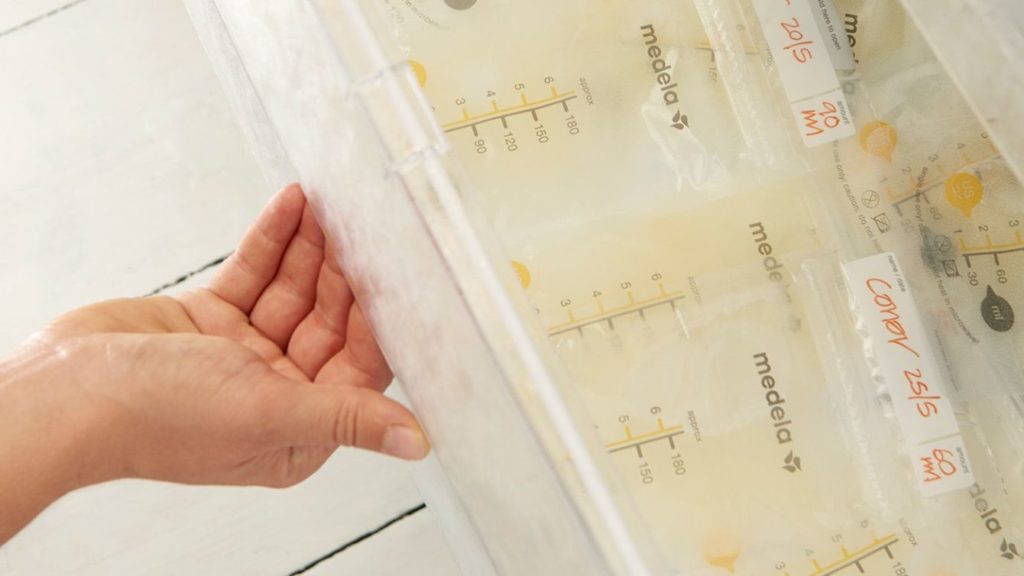From around the time your baby is a month old, your breast milk is fully mature. From now on, the composition of your breast milk won’t change much – unless your baby needs extra protection.

Your breast milk starts becoming mature after around two weeks, but it won’t be fully mature milk until your baby’s about four weeks old. From now on its composition will be broadly stable – it certainly won’t go through dramatic changes like in the first month.
Mature milk is live
Soon after it reaches maturity, your milk starts to contain higher quantities of some components that protect your baby against bacterial and viral infections.1 It’s probably no coincidence that this stage of breast milk production coincides with the time she starts grabbing objects and putting them in her mouth.
But the biggest fluctuation occurs if you or your baby pick up an infection. Then the proportion of white blood cells in your milk will rocket to fight it off.2
Like all stages of breast milk, mature milk is a living fluid. Even if we knew exactly what it was made of, and what all those things did (which scientists are still working out), we still wouldn’t be able to copy it exactly, because each mother’s milk is calibrated to her baby’s requirements.
“Breast milk is made from components that are brought to your breasts in your blood,” explains Professor Peter Hartmann, an expert on breast milk production, based at The University of Western Australia. “The milk-producing cells extract the components they need – and they’re pretty fussy about what they take!”
It’s nutrition, protection, body-builder and taste-former, all in one. And yet you never have to think about it, because your body produces the formulation your baby needs.
The difference between foremilk and hindmilk
At the start of each breastfeed your mature milk looks thinner and is commonly known as foremilk – although Professor Hartmann prefers the term ‘pre-milk’. As you nurse, your milk gradually becomes fattier, and is referred to as hindmilk or ‘post-milk’.
“The fat content relates to how full or drained the breast is,” explains Professor Hartmann. “The fat increases over the feed, until about 30 minutes afterwards, and then decreases as the breast refills. The concentrations of fat in pre- and post-milk depend on how much milk the baby has taken from the breast. So at one time of day the pre-milk could have a higher fat content than the post-milk at another time of day.
“Once a mother’s breast milk is mature, she will give about the same amount of fat to her baby over a 24-hour period, regardless of how often the baby breastfeeds,” he adds.
Mature milk is more than just nutrition
Although your baby needs to start eating solids when she’s around six months old, breast milk can still make up half her daily calorie intake – alongside other foods – well into her second year.3 And your amazing milk continues to play a role that goes far further than simple nutrition.
“We believe mammals initially started secreting milk to protect their young, and the nutritional function evolved later,” Professor Hartmann explains.“ So most of the compounds in breast milk that have a nutritive role are also protective in some way. It means there’s an awful lot of value in breast milk, but it makes things complicated when you’re researching it!”
He gives a few examples: alpha-lactalbumin, the major protein in breast milk, has antibacterial properties and helps stimulate your baby’s immune system.4 Lactoferrin, a protein that transports iron in the body, also has antifungal effects.5 And the fatty acids in human milk are antiviral and antibacterial too.6
Gut, immune system and brain development
All milk contains the sugar lactose, but breast milk also contains more than 200 human milk oligosaccharides.7 These complex sugars help create and protect a healthy gut, and develop the immune system. There’s nowhere near this number of oligosaccharides in cow’s milk or formula, and researchers are still working out their roles.8
Similarly, all milks contain fats, but the blend of fats in mature human milk is uniquely complex. Our brains are more complicated than other animals’ brains and, as more than half the human brain is made of fat,9 it stands to reason that we need custom-made fatty ingredients to help build that complexity.10
Humans are born at an early stage of development compared to other mammals, but during our first six months, our brain mass almost doubles.11 So it’s not surprising that our babies need more protection and brain-boosting nourishment during their early months and years.
“Your breast milk will be always better for your baby than any milk you can buy in the shops”
Proteins are complex molecules that play many important roles in our health. Some act as building blocks for growth and repair, while others help to bring about the essential chemical reactions taking place in our bodies. Your mature breast milk contains more than 1,000 different proteins12 that support your baby’s brain and immune system, alongside helping her grow.13
Mature breast milk is also rich in micronutrients: vitamins, minerals and trace elements, from calcium to cadmium, to support her development and wellbeing. The balance of these changes throughout the day to meet your baby’s needs.14
Some of your breast milk’s constituents might surprise you. “Mature milk has a high cholesterol content. It’s high in sugar, in the form of the simple carbohydrate lactose. And the proportion of protein is extremely low – it forms only 7% or 8% of a breastfed baby’s energy intake, compared to around 12% when she grows up,” reveals Professor Hartmann. “It’s not what we think of as suitable for adults but it’s ideal for babies – and shows how breast milk is tailored specifically to their needs.”
Breast milk ingredients that can’t be copied
Some elements of mature breast milk can’t be replicated because they’re unique to your own body. Nearly a third of the helpful bacteria in your baby’s gut come from your breast milk, and another 10% from the skin of your breast itself.15
Breast milk also contains stem cells, the ‘miracle cells’ that can renew themselves and change into other types of cell.16 Researchers are still working out their role in your milk and your baby’s development.
There are hormones in your mature milk too, including some that aid appetite control and the way your baby processes insulin.17 This may be one reason why children who were breastfed as babies are less likely to become overweight than those who were formula-fed.18
And because the food you eat affects the taste of your milk, your baby also gets to experience different flavours every day19 – something else formula can’t replicate.
“The differences between breast milk and formula are huge. One could spend all day going through the dissimilarities between the milks and the difficulties in actually trying to artificially produce a milk for babies,” says Professor Hartmann. “For example, the concentration of salt in cow’s milk, used to make formula, can be toxic to babies, so it needs to be highly processed.”
“However long you continue to breastfeed, your breast milk will always be better for your baby than any milk you can buy in the shops, or that scientists can create in a lab. It’s also a very convenient and cost-effective way of feeding your baby, and has wonderful health benefits for you as well as your little one.”
When it comes to feeding your baby, mother’s milk is truly the crème de la crème.
Interested in finding out more? Read our free ebook The Amazing Science of Mother’s Milk.
- Gao X et al. Temporal changes in milk proteomes reveal developing milk functions. J Proteome Res. 2012 Jul 6;11(7):3897-907.
- Hassiotou F et al. Maternal and infant infections stimulate a rapid leukocyte response in breastmilk. Clin Transl Immunology. 2013;2(4):e3.
- Dewey KG et al. Breast milk volume and composition during late lactation (7-20 months). J Pediatr Gastroenterol Nutr. 1984;3(5):713-720.
- Lönnerdal B, Lien EL. Nutritional and physiologic significance of α-lactalbumin in infants. Nutr Rev. 2003;61(9):295-305.
- Andersson Y et al. Lactoferrin is responsible for the fungistatic effect of human milk. Early Hum Dev. 2000;59(2):95-105.
- Gardner AS et al. Changes in fatty acid composition of human milk in response to cold-like xymptoms in the lactating mother and infant. Nutrients. 2017;9(9):1034.
- Moukarzel S, Bode L. Human milk oligosaccharides and the preterm infant: A journey in sickness and in health. Clin Perinatol 2017; 44(1):193–207.
- Jantscher-Krenn E, Bode L. Human milk oligosaccharides and their potential benefits for the breast-fed neonate. Minerva Pediatr. 2012;64(1):83-99.
- Chang CY et al. Essential fatty acids and human brain. Acta Neurol Taiwan. 2009 Dec;18(4):231-241.
- TED. TEDWomen: What we don’t know about mother’s milk [Internet]. New York, NY, USA: TED Conferences LLC; 2016. [Accessed 26.03.2018]. Available from www.ted.com/talk/katie_hinde_what_we_don_t_know_about_mother_s_milk/reading-list
- Dekaban AS. Changes in brain weights during the span of human life: relation of brain weights to body heights and body weights. Ann Neurol. 1978;4(4):345-356.
- Beck KL et al. Comparative proteomics of human and macaque milk reveals species-specific nutrition during postnatal development. J Proteome Res. 2015;14(5):2143-2157.
- Lönnerdal B. Infant formula and infant nutrition: bioactive proteins of human milk and implications for composition of infant formulas. Am J Clin Nutr. 2014;99(3):712S-717S.
- Karra MV, Kirksey A. Variation in zinc, calcium, and magnesium concentrations of human milk within a 24-hour period from 1 to 6 months of lactation. J Pediatr Gastroenterol Nutr. 1988;7(1):100-106.
- Pannaraj PS et al. Association between breast milk bacterial communities and establishment and development of the infant gut microbiome. JAMA Pediatr. 2017;171(7):647-654
- Hassiotou F et al. Breastmilk is a novel source of stem cells with multilineage differentiation potential. Stem Cells. 2012;30(10):2164-2174.
- Savino, F et al. Breast milk hormones and their protective effect on obesity. Int J Pediatr Endocrinol. 2009;2009:327505.
- Horta BL et al. Long-term consequences of breastfeeding on cholesterol, obesity, systolic blood pressure and type 2 diabetes: a systematic review and meta-analysis. Acta Paediatr. 2015;104(467):30-37.
- Mennella JA et al. Prenatal and postnatal flavor learning by human infants. Pediatrics. 2001;107(6):E88.














